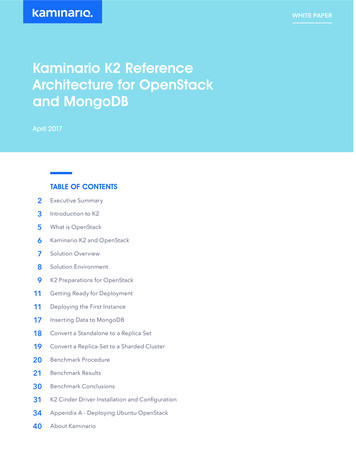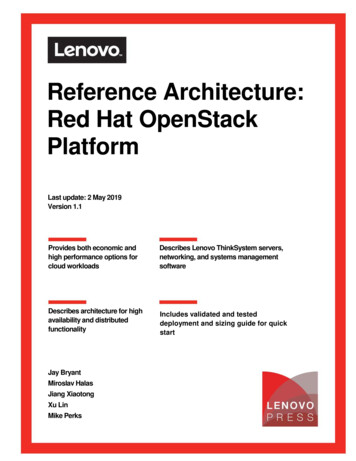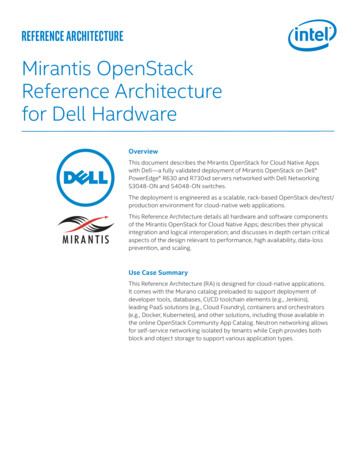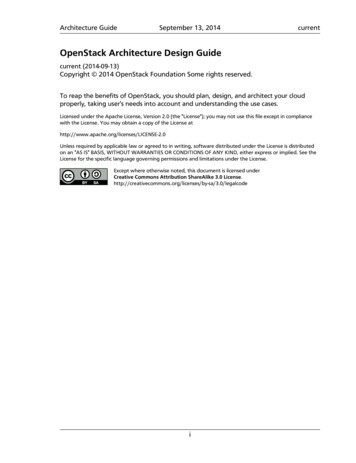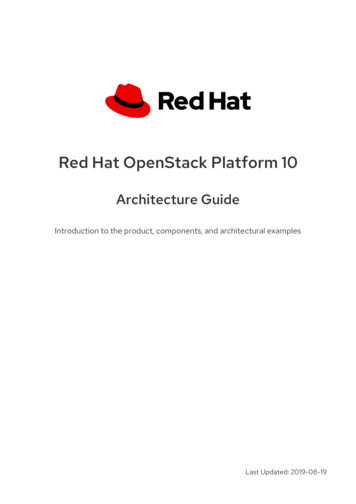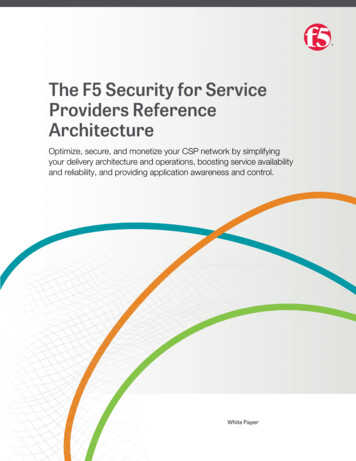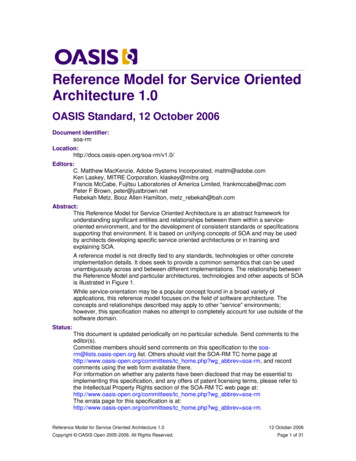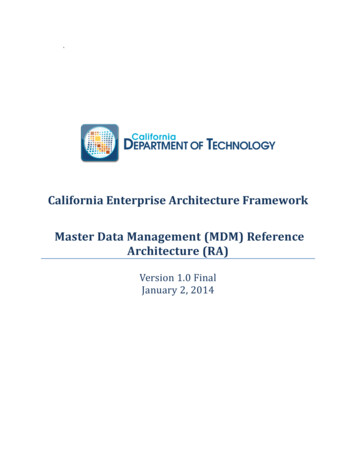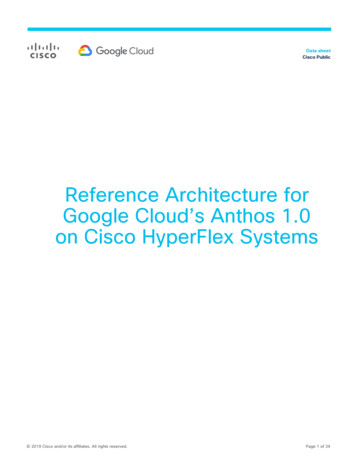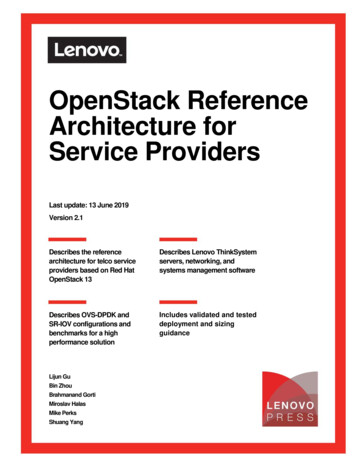
Transcription
OpenStack ReferenceArchitecture forService ProvidersLast update: 13 June 2019Version 2.1Describes the referencearchitecture for telco serviceproviders based on Red HatOpenStack 13Describes Lenovo ThinkSystemservers, networking, andsystems management softwareDescribes OVS-DPDK andSR-IOV configurations andbenchmarks for a highperformance solutionIncludes validated and testeddeployment and sizingguidanceLijun GuBin ZhouBrahmanand GortiMiroslav HalasMike PerksShuang YangClick here to check for updates
Table of Contents1Introduction. 12Business problem and business value . 22.1Business problem . 22.2Business value . 23Requirements. 33.1Functional requirements . 33.2Non-functional requirements . 34NFV overview and key technologies . 64.1NFV architecture . 64.2Key NFVI technologies . 75Component model . 125.1Core Red Hat OpenStack Platform components. 125.2Third-party components . 145.3Red Hat Ceph Storage component . 155.4Red Hat OpenStack Platform specific benefits . 166Operational model . 186.1Hardware components . 186.2Deployment mapping of OpenStack software components . 236.3Storage . 266.4Networking . 276.5Systems Management . 287NFVI & VNF characterization and benchmarking . 317.1Introduction to Network Services Benchmarking. 317.2Configuring the NSB testbed . 317.3Performance results . 36iiOpenStack Reference Architecture for Service ProvidersVersion 2.1
8Deployment example . 388.1Hardware configuration . 388.2Networking isolation . 398.3Cloud deployment for accelerated data networking . 418.4Storage implementation . 488.5Best practices . 489Appendix: Lenovo Bill of Materials . 509.1Server BOM . 509.2Networking BOM . 529.3Rack BOM. 539.4Red Hat subscription options . 53Resources. 54iiiOpenStack Reference Architecture for Service ProvidersVersion 2.1
1 IntroductionOpenStack continues to gain significant traction in the industry because of the growing adoption of cloudusage and the flexibility OpenStack offers as an open source product. The scope of OpenStack has grown inthe past few years to span Communications Service Providers (CSPs).Traditional networking is undergoing a major technological change where high-volume server platformsrunning virtual machines known as Virtual Network Functions (VNFs) are rapidly replacing purpose-builtnetwork appliances. This is called Network Functions Virtualization (NFV) and telecom operators and largeenterprises stand to benefit from this trend. OpenStack is proving to be the virtualization platform of choicewhen service providers deploy NFV.Comparing with traditional IT data centers, the NFV architecture requires high network bandwidth andcompute capacity to deliver maximum packet throughput and low latencies. The Data Plane Development Kit(DPDK) and Single-Root Input/Output Virtualization (SR-IOV) are two of the key network accelerationtechniques used by NFV.This document describes the Lenovo NFVI Reference Architecture (RA) for CSPs by using Red HatOpenStack Platform and DPDK and SR-IOV enabled on Lenovo hardware including industry leading servers,storage, networking, and Physical Infrastructure Management (PIM) tools from Lenovo.Lenovo and Red Hat have collaborated to promote best practices and validate reference architecture fordeploying private cloud infrastructure by leveraging the Red Hat OpenStack Platform 13. Red Hat OpenStackPlatform 13 is offered with 3 years of production support with the option to purchase an extended lifecyclesupport (ELS) for 4th and 5th years.The Lenovo NFVI platform provides an ideal infrastructure solution for NFV deployments. Lenovo serversprovide the full range of form factors, features and functions that are necessary to meet the needs of smalloperators all the way up to large service providers. Lenovo uses industry standards in systems managementon all these server platforms and enables seamless integration into cloud management tools such asOpenStack. Lenovo also provides data center network switches that are designed specifically for robust,scale-out server configurations and converged storage interconnect fabrics.The Lenovo XClarity Administrator solution consolidates systems management across multiple Lenovoservers that span the data center. XClarity, which serves as PIM in an NFV deployment, enables automationof firmware updates on servers via compliance policies, patterns for system configuration settings, hardwareinventory, bare-metal OS and hypervisor provisioning, and continuous hardware monitoring. XClarity easilyextends via the published REST API to integrate into other management tools.The intended audience for this document is IT and networking professionals, solution architects, salesengineers, and consultants. Readers should have a basic knowledge of Red Hat Enterprise Linux andOpenStack.1OpenStack Reference Architecture for Service ProvidersVersion 2.1
2 Business problem and business valueThis chapter outlines the value proposition of Lenovo NFVI solution for communication service providers(CSPs).2.1 Business problemCSPs are looking to transform their infrastructure to make it better suited for supporting 5G and IoT (Internetof Things) deployments. Data traffic over communications networks is growing rapidly with the trend expectedto continue for the foreseeable future. As a result, CSPs are evaluating and migrating to NFV at the datacenter and extending it to the central office and the network edge. Selecting next-generation infrastructurethat enables CSP workloads to run in a performance-optimized, secure and cost-effective manner is achallenge.2.2 Business valueThis reference architecture provides a blueprint for accelerating the design, piloting, and deployment of NFVby outlining a validated Lenovo NFVI configuration that scales and delivers enterprise-level reliability acrossservers, storage and networking. This solution presented in this Reference Architecture provides the followingbenefits: Consolidated and fully integrated hardware resources with balanced workloads for compute, network,and storage. Guidelines to configure OVS-DPDK and SR-IOV as distributed in Red Hat OpenStack Platform 13. Elimination of single points of failure in every layer by delivering continuous access to virtualmachines (VMs). Hardware redundancy and full utilization. Rapid OpenStack cloud deployment, including updates, patches, security, and usabilityenhancements with enterprise-level support from Red Hat and Lenovo. 2Unified management and monitoring for VMs.OpenStack Reference Architecture for Service ProvidersVersion 2.1
3 RequirementsThe functional and non-functional requirements for this reference architecture are desribed below.3.1 Functional requirementsTable 1 lists the functional requirements for a cloud solution implementation.Table 1. Functional requirementsRequirementDescriptionMobilityWorkload is not tied to anySupported by physical locationEnabled VM is booted from distributedstorage and runs on different hosts Live migration of running VMs Rescue mode support for hostmaintenanceResource provisioningPhysical servers, virtual OpenStack compute servicemachines, virtual storage, and OpenStack block storage service OpenStack network service OpenStack bare-metal provisioningvirtual network can beprovisioned on demandserviceManagement portalWeb-based dashboard for OpenStack dashboard (Horizon) for mostworkloads managementMulti-tenancyResources are segmentedroutine management operations Built-in segmentation and multi-tenancy inbased on tenancyMeteringCollect measurements of usedOpenStack OpenStack metering service (Ceilometer)resources to allow billing3.2 Non-functional requirementsTable 2 lists the non-functional requirements for a service provider cloud implementation.Table 2. Non-functional requirementsRequirementDescriptionOpenStack environmentSupports the currentSupported by OpenStack editionScalabilitySolution components canscale for growthOpenStack Queens release throughRed Hat OpenStack Platform 13 Compute nodes and storage nodes canbe scaled independently within a rack oracross racks without service downtime3OpenStack Reference Architecture for Service ProvidersVersion 2.1
RequirementDescriptionLoad balancingWorkload is distributedSupported by evenly across serversUse of OpenStack scheduler forbalancing compute and storageresources Data blocks are distributed acrossstorage nodes and can be rebalancedon node failureHigh availabilitySingle component failure Hardware architecture ensures thatwill not lead to whole systemcomputing service, storage service, andunavailabilitynetwork service are automatically switchedto remaining components Network Interfaces are bonded to preventsingle point of failures in the data path andcontrol path Controller node, and storage node areredundant Data is stored on multiple servers andaccessible from any one of them; therefore,no single server failure can cause loss ofdata Virtual machines are persistent on sharedstorage serviceMobilityVM can be migrated or VM migrationevacuated to different VM evacuation Lenovo ThinkSystem server, networkhosting serverPhysical footprintCompact solutiondevices, and software are integrated intoone rack with validated performance andreliabilityEase of installationReduced complexity for Provides 1U compute node option A dedicated deployment server with web-solution deploymentbased deployment tool and rich commandline provide greater flexibility and controlover how you deploy OpenStack in yourcloud 4Optional deployment servicesOpenStack Reference Architecture for Service ProvidersVersion 2.1
RequirementDescriptionSupported bySupportAvailable vendor support Hardware warranty and software supportare included with component products Standard or Premium support from Red Hatincluded with Red Hat OpenStack Platformand Optional Red Hat Ceph StoragesubscriptionFlexibilitySolution supports variable deployment methodologiesHardware and software components can bemodified or customized to meet variousunique customer requirements Provides local and shared storage forworkloadRobustnessSolution continuously works without routine supervisionRed Hat OpenStack Platform 13 isintegrated and validated on Red HatEnterprise Linux 7.5 Integration tests on hardware and softwarecomponentsSecuritySolution provides means to Security is integrated in the Lenovosecure customerThinkSystem hardware with ThinkSysteminfrastructureTrusted Platform Assurance, an exclusiveset of industry-leading security features andpractices SELinux is enabled and in enforcing modeby default in Red Hat OpenStack Platform10 and above versions. Network isolation using virtual LAN (VLAN)and virtual extensible LAN (VXLAN).High performanceSolution components are high-performanceProvides 40 - 90 average workloads (2vCPU, 8 GB vRAM, 80 GB disk) per host. OVS-DPDK or SR-IOV can be enabled onNFV compute nodes to provide highthroughput and low latency.5OpenStack Reference Architecture for Service ProvidersVersion 2.1
4 NFV overview and key technologiesTh
OpenStack Reference Architecture for Service Providers Describes the reference architecture for telco service providers based on Red Hat OpenStack 1 3 Describes Lenovo ThinkSystem servers, networking, and systems management software Describes OVS -DPDK and SR-IOV configurations and benchmarks for a high performance solution Includes validated and tested deployment and sizing guidance Last .
